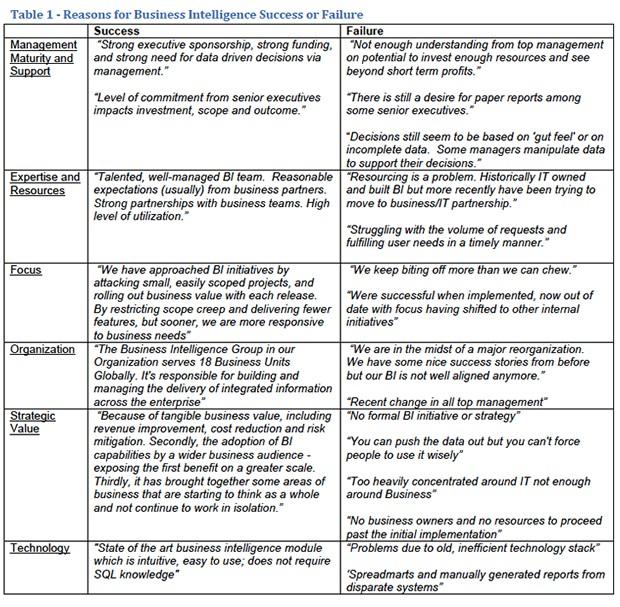Thinking of investing in Business Intelligence (BI)? Nothing less than a fully committed approach will do. Nothing half-hearted, apathetic, irresolute, lackluster, perfunctory, tame or tepid will suffice.
Unwavering dedication – like Shriek on a quest, The Power Rangers on a mission, or Batman’s paternal protection of constantly crisis-stricken Gotham city – is required. Why?

Because according to Dresner Advisory Services (DAS) latest Wisdom of Crowds Business Intelligence Market Study, 59 percent of BI projects aren’t successful.
So, what are the factors underpinning this abysmal figure?
Traditional BI falters
Dresner’ 2012s global Wisdom of Crowds report – based on 859 responses from professionals with first-hand experience using vendor products and services – demonstrated a notable shift away from traditional BI vendors and products in favor of new generation self-service BI deployments.
The study compared and ranked 17 of the world’s foremost BI vendors on a five-point scale, across 33 different criteria, based on seven categories, including: Sales experience, value, quality and usefulness of product, quality of technical support, quality and value of consulting services, integrity and whether existing clients would recommend the vendor and its product to others.
The study divided vendors into four different sub groups:
- “Titans” – the largest and long-established BI players (IBM Cognos, Microsoft, Oracle and SAP Business Objects)
- “Large Established Pure-Play” – BI vendors predominately focused on BI software and services with business background of 15 or more years (Actuate, Information Builders, MicroStrategy and SAS institute)
- “High Growth” – BI vendors that have achieved critical mass in the market and are growing at an extremely high rate (Qliktech, Tableau and Tibco Spotfire)
- “Emerging” – BI vendors that are typically younger than other categories and offer unique and often innovative business models, technologies and/or services (Acrplan, Dimensional Insight, Jedox, Pentaho, Jaspersoft and Yellowfin)
Importantly, the report found that users of new business-user-oriented BI solutions experienced higher degrees of success: “Users of Emerging and High Growth segment products were more likely to report success than other segments.”

Conversely, a higher proportion of users of “Titan” and “Large Established” BI products experienced difficulty:
- 17% of users of “Titan” technology either disagreed or disagreed somewhat that their BI initiative had been a success
- 10% of users of “Large Established” technology either disagreed or disagreed somewhat that their BI initiative had been a success
- 7% of users of “High Growth” technology either disagreed or disagreed somewhat that their BI initiative had been a success
- Only 4% of users of “Emerging” technology either disagreed or disagreed somewhat that their BI initiative had been a success
Download your free copy of the report and find out why Yellowfin received the equal highest overall ranking and highest outright score in the study’s “Emerging Business Intelligence Vendors” sub group. Download Now >
BI success by size of organization: The bigger you are the harder you fall…
The report also discovered that, whilst a typical linear relationship between organization size and BI success rates was not evident, larger organizations tended to struggle to attain the value sought from BI when compared to nimbler businesses of smaller staff counts.

“When examining perceived success by the size of organization, we find that smaller organizations are more likely to have Business Intelligence success than larger ones,” stated the report.
However, given the inherent complexities within large, or larger, scale enterprise technology deployments, the disparity in reported total success rates – where respondents “completely agree” that their BI initiatives have been a success – is somewhat predictable.
“This shouldn’t come as a surprise as smaller organizations are better able to more quickly deploy BI and receive the requisite benefits due to reduced organizational and business complexity,” stated the report.
The report was also quick to point out that even though the largest organizations reported the lowest levels of success, 83 percent of companies with 10,000 or more employees still completely agreed, or agreed somewhat, that their BI programs were successful.
Key reasons for BI success of failure
Survey respondents had the opportunity to record the key reasons that – they perceived – had affected the success or failure of their organizations’ BI deployments.

Lessons learnt: You can lead a horse to water but you can’t make it drink
Curiously, perhaps the biggest criterion for BI success is inadvertently offered in the second last cell of the “failure” column within the above table.
Firstly, this disgruntled respondent alluded to a cultural problem, proclaiming that “You can push the data out but you can’t force people to use it wisely”.
Establishing a culture of fact-based decision-making is the only way to ensure that the potential benefits of reporting and analytics are exploited and realized. If management, and supposed executive sponsors, continue to rely on a “gut feel” approach to boardroom decision-making after implementation, disparity between strategic direction and the BI environment will quickly emerge. The effort to collect, collate and extract valuable information from organizational data sets will prove a wasted, redundant exercise. In fact, recent research from advisory and analyst goliath, Gartner, suggested that somewhere between 70 and 80 percent of BI projects result in failure. For more on how poor user adoption affects BI success rates, check out our blog Business Intelligence and user adoption: A Depp-esc disaster?
Secondly, much current BI research has signaled the necessary demise of traditional IT-centric BI technologies and deployments, as such outdated approaches struggle to meet constantly shifting business-oriented information and functionality demands. So, if you’re BI deployment is also “Too heavily concentrated around IT and not enough around Business”, find out why it’s time to move on in our recent blog post – Rethinking Business Intelligence.
